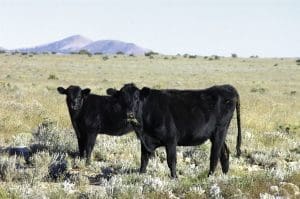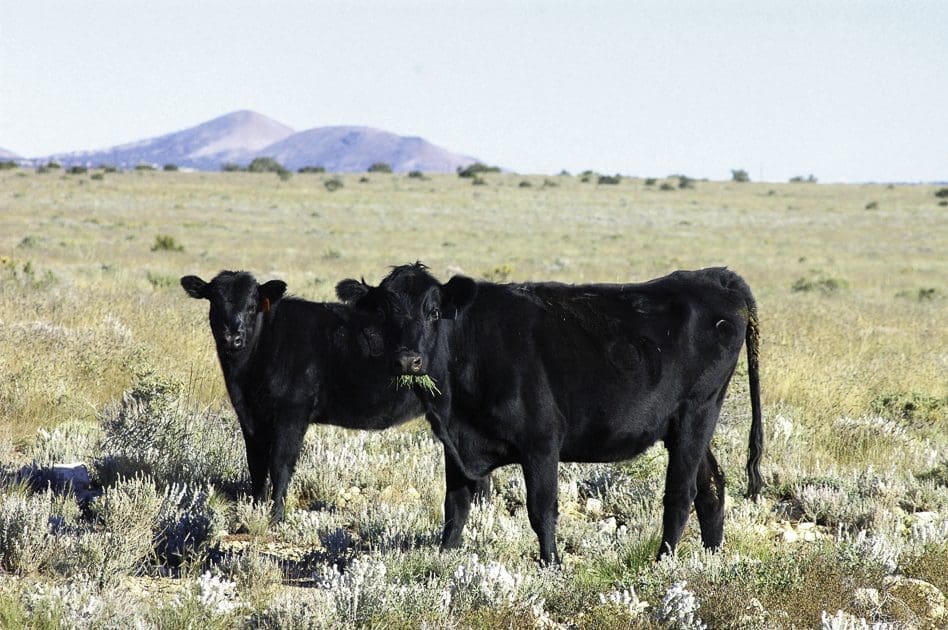By Larry Stalcup Contributing Editor

“Forgoing meat is not the environmental panacea many would have us believe.”
– Frank Mitloehner
When representatives of 196 countries signed the Paris Climate Accord (PCA) just before Christmas 2015, one wonders how many of them believed that cow, bull, calf and yearling farts and belches were the main reasons world temperatures were climbing. Regrettably, despite research that proves cattle are actually upcyclers that recycle beneficial carbon, there are still calls for reductions of cattle to save the planet.
There are allegations that PCA will fail without slashing methane emissions from dairy and beef cattle. In 2021, the United Nations Environment Programme (UNEP) and the Climate and Clean Air Coalition stated that cutting farming-related methane emissions would be key in the battle against climate change.
As late as March 2023, some environmental-oriented media promoted the UNEP findings. That’s about three years after renowned University of California-Davis scientist Frank Mitloehner denounced allegations that cattle are destroying the climate. His research has proved that cattle essentially enhance the environment.
Also known as the Paris Climate Agreement, PCA was adopted at the United Nations Climate Change Conference in 2015. It grew from growing climate concerns following the 1992 United Nations Framework Convention on Climate Change. It focused on the period after the Industrial Revolution, which started in the early 1800s with the advent of the steam engine.
PCA’s goal included measures to hold “the increase in the global average temperature to well below 2° C above pre-industrial levels.” It also strives “to limit the temperature increase to 1.5° C (about 34° F) above pre-industrial levels.”
Since the UN’s Intergovernmental Panel on Climate Change says the 1.5° C level may cause more severe droughts, heat waves and rain worldwide, there’s a drive to limit global warming to 1.5° C by the end of this century. To reach that limit, the panel says greenhouse gas emissions must peak before 2025 and decline 43 percent by 2030.
Climate Changes
Whether we believe that humans are causing temperatures to rise, or that variations in temperatures come naturally, there’s no doubt that the climate is changing, as it has before. Overall temperatures are warmer worldwide, according to NASA data (https://climate.nasa.gov/evidence/?t).
There are famine-causing droughts in Africa and other regions. Farmers and ranchers have been forced to take steps hopefully to offset hot, dry weather. Forage and crop breeders have helped develop more drought-tolerant varieties. Livestock producers continue to learn better ways to manage pastures in dry periods.
But for more senior U.S. producers, there are memories of the dreadful droughts of the 1950s. And the Dust Bowl of the 1930s was fueled by drought. In the Southwest, many producers feel they’re waiting for the next drought every time they plant a crop or restock pastures.
However, there are those – maliciously termed as “climate deniers” – who claim the earth is not imploding. In 2019, the American Enterprise Institute reported that a group of 500 worldwide climate experts sent a letter to the UN claiming the 21st-century climate emergency was false. They held that the models for determining international climate policy were “unfit for purpose.”
The letter indicated that climate change is impacted both naturally, as well as from “anthropogenic” factors. Nonetheless, the letter stressed, “… warming is far slower than predicted, climate policy relies on inadequate models, CO2 is not a pollutant, and global warming has not increased natural disasters. … Climate policy must respect scientific and economic realities and there is no climate emergency. Therefore, there is no cause for panic.”
The letter’s support for CO2 added, “It is a plant food that is essential to all life on Earth. Photosynthesis is a blessing. More CO2 is beneficial for nature, greening the Earth: Additional CO2 in the air has promoted growth in global plant biomass. It is also good for agriculture, increasing the yields of crops worldwide.”
PCA’s Anti-Ag Stance Issues
The National Agriculture Law Center, a division of the University of Arkansas Ag Center, notes that although the PCA does not mention agriculture, it highlights the role of food security, hunger and the vulnerability of the food production system in the face of climate change. “Agriculture has made its way into conversations surrounding climate change, both as a contributor to climate change and a sector that will be highly affected by climate change,” the law center says.
The UNEP acknowledges that the growth in world population will create a 70 percent greater demand for animal protein by 2050 – but more animal protein will increase methane’s damage to the climate. It contends that livestock emissions – “from manure and gastroenteric releases” – are the main cause.
“Methane has accounted for roughly 30 percent of global warming since pre-industrial times and is proliferating faster than at any other time since record-keeping began in the 1980s,” UNEP alleges.
“The world needs to rethink our approaches to agricultural cultivation and livestock production,” argues James Lomax, UNEP Food Systems and Agriculture advisor. “That includes leveraging new technology, shifting toward plant-rich diets (yep, there it is) and embracing alternative sources of protein. … That will be key if humanity is to slash greenhouse gas emissions and limit global warming to 1.5° C.”
In November 2022, the United States and European Union led the creation of the Global Methane Pledge. The Pledge now has 111 participating countries, which it says are responsible for 45 percent of global human-caused methane emissions. By 2030, the Pledge strives to collectively reduce methane emissions by at least 30 percent below 2020 levels. Cattle, along with fossil fuels, are among its main targets for reducing greenhouse emissions.
Upcyclers to the Rescue
Mitloehner is doing his best to set the record straight on methane. He has carried his message to numerous climate-oriented forums worldwide. Many United States and foreign cattle groups have heard his presentations. “Methane from cattle is a potent greenhouse gas with a warming potential more than 28 times that of carbon dioxide (CO2),” he says. “But when it comes to livestock and climate change, there are many other characteristics that set biogenic methane [methane from cattle] apart from CO2.”
Mitloehner says methane from cattle stays in the earth’s atmosphere for about 10 years and comes from atmospheric carbon, which is part of the biogenic carbon cycle. It eventually returns to the atmosphere as CO2, making it recycled carbon.
“Forgoing meat is not the environmental panacea many would have us believe,” Mitloehner says, noting that cows and other ruminants account for just 4 percent of all greenhouse gases produced in the United States, and beef cattle account for just 2 percent of direct emissions.
“We’re now feeding more people with fewer cattle,” Mitloehner says. “Better breeding, genetics and nutrition have increased the efficiency of livestock production in the United States In the 1970s, 140 million head of cattle were needed to meet demand. Now, just 90 million head are required. At the same time, those 90 million cattle are producing more meat.”
He says methane from fossil fuels doesn’t have all the same characteristics as biogenic methane from ruminate animals. “Fossil methane shares more traits with CO2 from fossil fuels in how it warms our planet since it’s pulled from the earth and not derived from atmospheric carbon,” he says.
Cattle Climate Neutrality by 2040
Research from Mitloehner and others has given the National Cattlemen’s Beef Association (NCBA) more ammunition to educate the scientific community and consumers on how cattle production benefits the environment. NCBA points out that, according to the UN Food and Agriculture Organization, “the U.S. beef supply chain has the lowest greenhouse gas emissions footprint of all beef-producing countries in the world and has been the global leader since 1996.”
With a commitment to achieve climate neutrality of U.S. cattle production by 2040, NCBA hails its members as those using up-to-date research and technologies related to carbon sequestration and emissions reduction.
Even before the NCBA’s goal of climate neutrality by 2040 was set in 2021, producers told their stories to Congress about how the beef industry helps Mother Nature. “According to the EPA, direct emissions from beef cattle represent 2 percent of all greenhouse gas emissions in the country,” said Kansas Flint Hills rancher Debbie Beth Lyons-Blythe at a 2019 House Ag Committee hearing. “A recent study published by the USDA found that emissions from cattle were not a significant contributor to long-term global warming.”
She also highlighted her work as a board member with the U.S. Roundtable for Sustainable Beef. The Roundtable has a U.S. Beef Industry Sustainability Framework, which encourages operations all along the beef value chain to measure key environmental metrics like water resources, air and greenhouse gas emissions and land resources.
“The Roundtable is an example of ranchers leading the way on conservation,” she said. “Cattle ranchers took the initiative to identify their unique footprint in beef sustainability, demonstrating their positive contributions to landscapes, wildlife populations, rural communities, our nation’s economy, and a global food supply.”
In May 2023, NCBA President Todd Wilkinson testified before another House committee. Climate and the environment were among his topics. “Cattle spend most of their lives grazing on pasture, oftentimes on ground that is unsuitable for producing crops,” he said. “Between their consumption of otherwise inedible forage and the use of other food by-products in cattle feed, 90 percent of what cattle consume is inedible to humans.”
According to NCBA, “The cattle industry is committed to showing it is part of the solution in mitigating climate-related risks.”
Yet, despite scientific proof that cattle production benefits the environment, calls for reduced livestock production will likely continue. These, let’s call them “upcycler-deniers,” will still target cattle emissions from both ends of the bovine as causers of climate change.
The previously mentioned American Enterprise Institute report argues, “The voices of those challenging the [alleged climate change] consensus are always drowned out by the tsunami of climate hysteria from the climate alarmists.”
Hopefully, leaders of the Paris Climate Accord will take a second and third look at the facts regarding cattle emissions. Possibly they will say au revoir to thoughts that cattle farts and belches are threats to climate change.
As far as the beef industry goes, that theory emits a distinct odor.







